Toyota Corolla Hybrid (2022 year). Manual in english — page 30
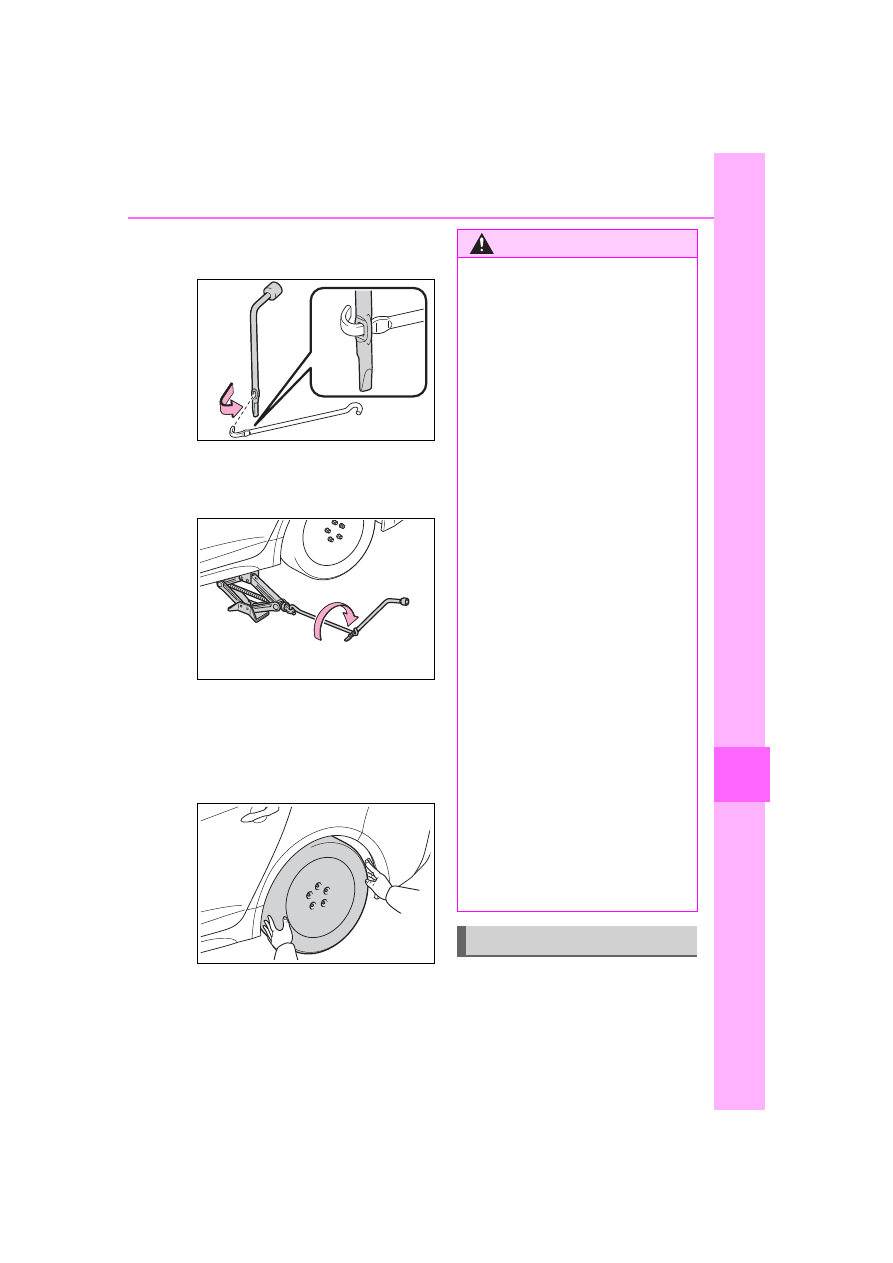
489
8-2. Steps to take in an emergency
8
W
he
n
tro
ub
le
ar
is
es
5
Assemble the jack handle
extension.
6
Raise the vehicle until the tire
is slightly raised off the
ground.
7
Remove all the wheel nuts
and the tire.
When resting the tire on the
ground, place the tire so that the
wheel design faces up to avoid
scratching the wheel surface.
1
Remove any dirt or foreign
matter from the wheel con-
tact surface.
WARNING
■
Replacing a flat tire
●
Do not touch the disc wheels or
the area around the brakes
immediately after the vehicle
has been driven. After the vehi-
cle has been driven the disc
wheels and the area around the
brakes will be extremely hot.
Touching these areas with
hands, feet or other body parts
while changing a tire, etc. may
result in burns.
●
Failure to follow these precau-
tions could cause the wheel
nuts to loosen and the tire to fall
off, resulting in death or serious
injury.
• Have the wheel nuts tightened
with a torque wrench to 76 ft•lbf
(103 N•m, 10.5 kgf•m) as soon
as possible after changing
wheels.
• Do not attach a heavily dam-
aged wheel ornament, as it may
fly off the wheel while the vehi-
cle is moving.
• When installing a tire, only use
wheel nuts that have been spe-
cifically designed for that wheel.
• If there are any cracks or defor-
mations in the bolt screws, nut
threads or bolt holes of the
wheel, have the vehicle
inspected by your Toyota
dealer.
• When installing the wheel nuts,
be sure to install them with the
tapered ends facing inward.
Installing the spare tire

490
8-2. Steps to take in an emergency
If foreign matter is on the wheel
contact surface, the wheel nuts
may loosen while the vehicle is in
motion, causing the tire to come off.
2
Install the tire and loosely
tighten each wheel nut by
hand by approximately the
same amount.
Tighten the wheel nuts until the
tapered portion
comes into
loose contact with the disc wheel
seat
.
3
Lower the vehicle.
4
Firmly tighten each wheel nut
two or three times in the
order shown in the illustra-
tion.
Tightening torque:
76 ft•lbf (103 N•m, 10.5 kgf•m)
5
Stow the flat tire, tire jack and
all tools.
■
The compact spare tire
●
The compact spare tire is identi-
fied by the label “TEMPORARY
USE ONLY” on the tire sidewall.
Use the compact spare tire tempo-
rarily, and only in an emergency.
●
Make sure to check the tire infla-
tion pressure of the compact
spare tire. (
■
When the compact spare tire is
equipped
The vehicle becomes lower when
driving with the compact spare tire
compared to when driving with stan-
dard tires.
■
After completing the tire
change (vehicles with a tire
pressure warning system)
The tire pressure warning system
must be reset. (
■
When using the compact spare
tire (vehicles with a tire pres-
sure warning system)
As the compact spare tire is not
equipped with a tire pressure warn-
ing valve and transmitter, low infla-
tion pressure of the spare tire will
not be indicated by the tire pressure
warning system. Also, if you replace

491
8-2. Steps to take in an emergency
8
W
he
n
tro
ub
le
ar
is
es
the compact spare tire after the tire
pressure warning light comes on,
the light remains on.
■
If you have a flat front tire on a
road covered with snow or ice
Install the compact spare tire on one
of the rear wheels of the vehicle.
Perform the following steps and fit
tire chains to the front tires:
1
Replace a rear tire with the com-
pact spare tire.
2
Replace the flat front tire with the
tire removed from the rear of the
vehicle.
3
Fit tire chains to the front tires.
■
When reinstalling the wheel
ornament (except compact
spare tire)
Align the cutout of the wheel orna-
ment with the valve stem as shown
in the illustration.
WARNING
■
When using the compact
spare tire
●
Remember that the compact
spare tire provided is specifi-
cally designed for use with your
vehicle. Do not use your com-
pact spare tire on another vehi-
cle.
●
Do not use more than one com-
pact spare tires simultaneously.
●
Replace the compact spare tire
with a standard tire as soon as
possible.
●
Avoid sudden acceleration,
abrupt steering, sudden brak-
ing and shifting operations that
cause sudden engine braking.
■
When the compact spare tire
is attached
The vehicle speed may not be
correctly detected, and the follow-
ing systems may not operate cor-
rectly:
• ABS & Brake assist
• VSC
• TRAC
• Automatic High Beam
• Dynamic radar cruise control
with full-speed range
• EPS
• PCS (Pre-Collision System)
• LTA (Lane Tracing Assist)
• Tire pressure warning system (if
equipped)
• BSM (Blind Spot Monitor) (if
equipped)
• RCTA (Rear Cross Traffic Alert)
function (if equipped)
• Rear view monitor system
■
Speed limit when using the
compact spare tire
Do not drive at speeds in excess
of 50 mph (80 km/h) when a com-
pact spare tire is installed on the
vehicle.
The compact spare tire is not
designed for driving at high
speeds. Failure to observe this
precaution may lead to an acci-
dent causing death or serious
injury.
492
8-2. Steps to take in an emergency
WARNING
■
After using the tools and jack
Before driving, make sure all the
tools and jack are securely in
place in their storage location to
reduce the possibility of personal
injury during a collision or sudden
braking.
NOTICE
■
Be careful when driving over
bumps with the compact
spare tire installed on the
vehicle.
The vehicle becomes lower when
driving with the compact spare tire
compared to when driving with
standard tires. Be careful when
driving over uneven road sur-
faces.
■
Driving with tire chains and
the compact spare tire
Do not fit tire chains to the com-
pact spare tire. Tire chains may
damage the vehicle body and
adversely affect driving perfor-
mance.
■
When replacing the tires
(vehicles with a tire pressure
warning system)
When removing or fitting the
wheels, tires or the tire pressure
warning valve and transmitter,
contact your Toyota dealer as the
tire pressure warning valve and
transmitter may be damaged if not
handled correctly.
■
To avoid damage to the tire
pressure warning valves and
transmitters (vehicles with a
tire pressure warning system)
When a tire is repaired with liquid
sealants, the tire pressure warn-
ing valve and transmitter may not
operate properly. If a liquid seal-
ant is used, contact your Toyota
dealer or other qualified service
shop as soon as possible. Make
sure to replace the tire pressure
warning valve and transmitter
when replacing the tire.
493
8-2. Steps to take in an emergency
8
Whe
n tr
ouble
ar
ises
One of the following may be the
cause of the problem:
The electronic key may not be
functioning properly.
(
There may not be sufficient
fuel in the vehicle’s tank.
Refuel the vehicle.
There may be a malfunction
in the immobilizer system.
(
P.88)
There may be a malfunction
in the steering lock system.
The hybrid system may be
malfunctioning due to an elec-
trical problem such as elec-
tronic key battery depletion or
a blown fuse. However,
depending on the type of mal-
function, an interim measure
is available to start the hybrid
system. (
One of the following may be the
cause of the problem:
The 12-volt battery may be
discharged. (
The 12-volt battery terminal
connections may be loose or
corroded. (
One of the following may be the
cause of the problem:
The 12-volt battery may be
discharged. (
One or both of the 12-volt bat-
tery terminals may be discon-
nected. (
Contact your Toyota dealer if the
problem cannot be repaired, or if
repair procedures are unknown.
When the hybrid system does
not start, the following steps can
be used as an interim measure
to start the hybrid system if the
power switch is functioning nor-
mally.
Do not use this starting proce-
dure except in case of emer-
If the hybrid system
will not start
Reasons for the hybrid sys-
tem not starting vary
depending on the situation.
Check the following and
perform the appropriate
procedure:
The hybrid system will not
start even though the cor-
rect starting procedure is
being followed. (
The interior lights and
headlights are dim, or the
horn does not sound or
sounds at a low volume.
The interior lights and
headlights do not turn on,
or the horn does not
sound.
Emergency start function
494
8-2. Steps to take in an emergency
gency.
1
Set the parking brake.
(
2
Check that the shift lever is in
P.
3
Turn the power switch to
ACC.
4
Press and hold the power
switch for about 15 seconds
while depressing the brake
pedal firmly.
Even if the hybrid system can be
started using the above steps, the
system may be malfunctioning.
Have the vehicle inspected by your
Toyota dealer.
If you lose your keys
New genuine keys can be
made by your Toyota dealer
using another mechanical
key and the key number
stamped on your key num-
ber plate.
Keep the plate in a safe
place such as your wallet,
not in the vehicle.
NOTICE
■
When an electronic key is lost
If the electronic key remains lost,
the risk of vehicle theft increases
significantly. Visit your Toyota
dealer immediately with all
remaining electronic keys that
were provided with your vehicle.
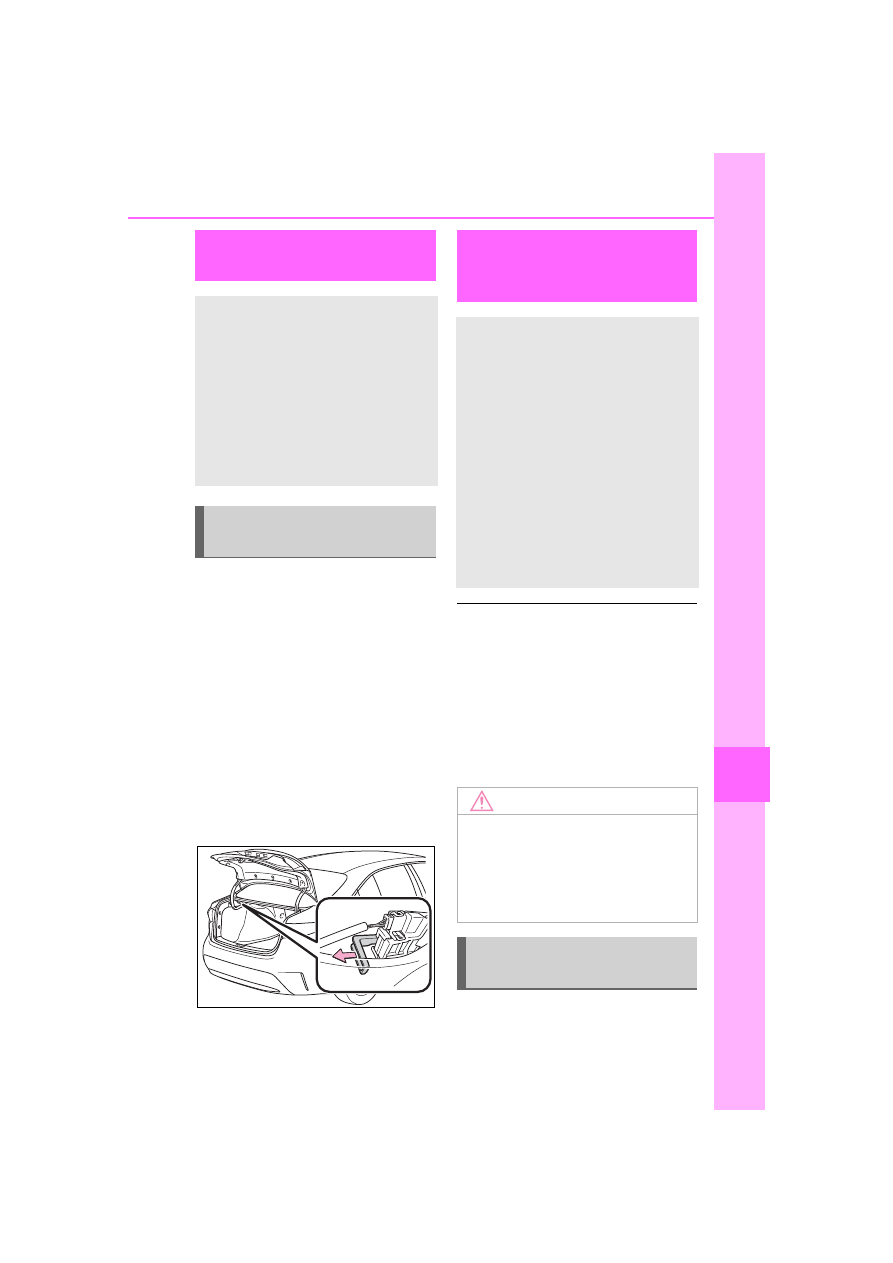
495
8-2. Steps to take in an emergency
8
W
he
n
tro
ub
le
ar
is
es
Pull the lever.
Using the lever to open the fuel
filler door may not allow for an
adequate reduction in fuel tank
pressure before refueling. To
prevent fuel from spilling out,
turn the cap slowly when remov-
ing it. During refueling, fuel may
spill out from the filler opening
due to air being discharged from
inside the fuel tank. Therefore,
fill the fuel tank carefully and
slowly.
■
When the electronic key does
not work properly
●
Make sure that the smart key sys-
tem has not been deactivated in
the customization setting. If it is
off, turn the function on. (Custom-
izable features:
●
Check if battery-saving mode is
set. If it is set, cancel the function.
(
Use the mechanical key
(
P.116) in order to perform the
If the fuel filler door
cannot be opened
If the fuel filler door opener
switch cannot be operated,
contact your Toyota dealer
to service the vehicle. In
case where refueling is
urgently necessary, the fol-
lowing procedure can be
used to open the fuel filler
door.
Opening the fuel filler
door
If the electronic key
does not operate prop-
erly
If communication between
the electronic key and vehi-
cle is interrupted (
or the electronic key cannot
be used because the battery
is depleted, the smart key
system and wireless remote
control cannot be used. In
such cases, the doors can
be opened and the hybrid
system can be started by
following the procedure
below.
NOTICE
■
In case of a smart key system
malfunction or other
key-related problems
Take your vehicle with all the elec-
tronic keys provided with your
vehicle to your Toyota dealer.
Locking and unlocking
the doors
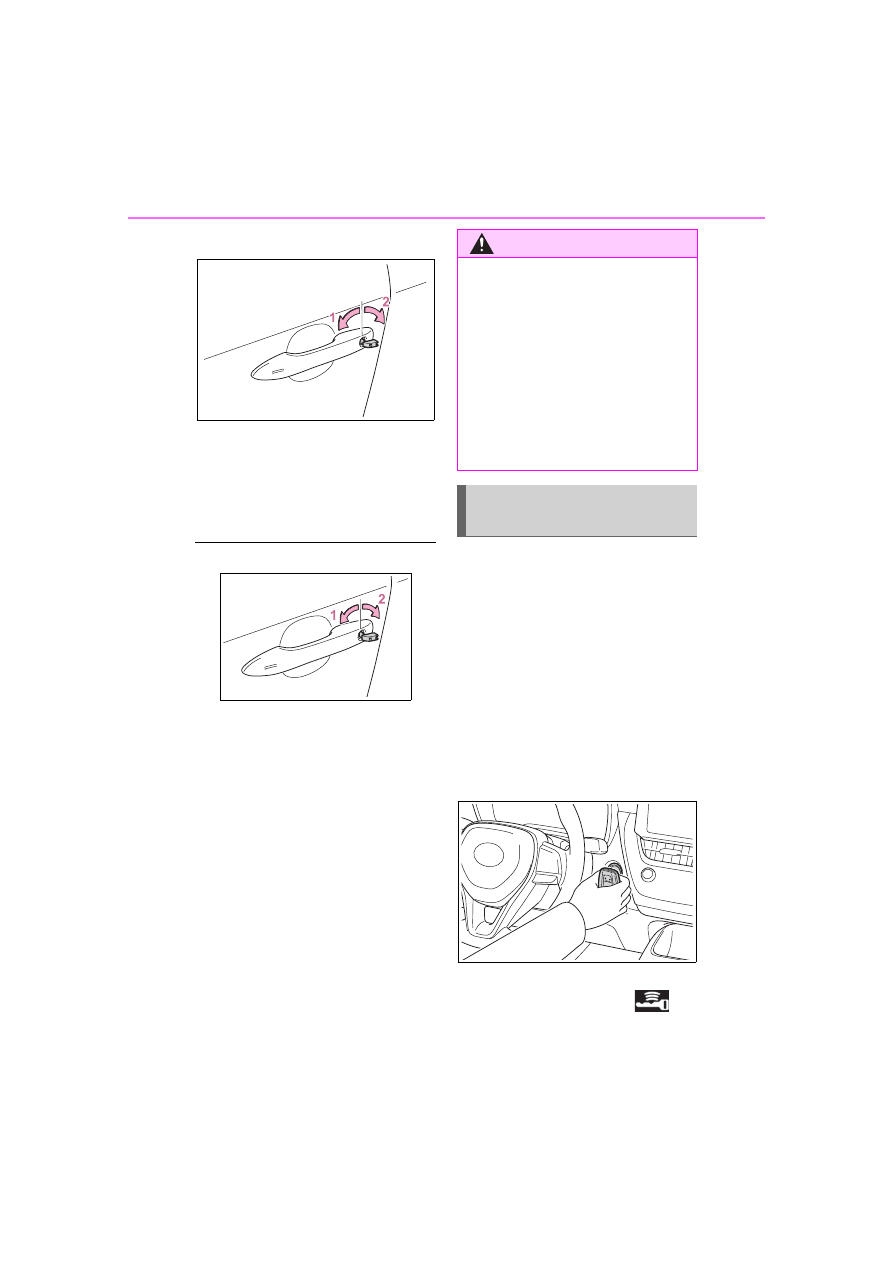
496
8-2. Steps to take in an emergency
following operations:
1
Locks all the doors
2
Unlocks all the doors
Turning the key unlocks the driver’s
door. Turning the key again unlocks
the other doors.
■
Key linked functions
1
Closes the windows (turn and
hold)
*
2
Opens the windows (turn and
hold)
*
*
: This setting must be customized
at your Toyota dealer.
1
Ensure that the shift lever is
in P and depress the brake
pedal.
2
Touch the Toyota emblem
side of the electronic key to
the power switch.
When the electronic key is
detected, a buzzer sounds and the
power switch will turn to ON.
When the smart key system is
deactivated in customization set-
ting, the power switch will turn to
ACC.
3
Firmly depress the brake
pedal and check that
is
WARNING
■
When using the mechanical
key and operating the power
windows
Operate the power window after
checking to make sure that there
is no possibility of any passenger
having any of their body parts
caught in the window.
Also, do not allow children to
operate the mechanical key. It is
possible for children and other
passengers to get caught in the
power window.
Starting the hybrid sys-
tem
497
8-2. Steps to take in an emergency
8
Whe
n tr
ouble
ar
ises
shown on the multi-informa-
tion display.
4
Press the power switch
shortly and firmly.
In the event that the hybrid sys-
tem still cannot be started, con-
tact your Toyota dealer.
■
Stopping the hybrid system
Shift the shift lever to P and press
the power switch as you normally do
when stopping the hybrid system.
■
Electronic key battery
As the above procedure is a tempo-
rary measure, it is recommended
that the electronic key battery be
replaced immediately when the bat-
tery is depleted. (
■
Changing power switch modes
Release the brake pedal and press
the power switch in step
3
above.
The hybrid system does not start
and modes will be changed each
time the switch is pressed. (
If the 12-volt battery is
discharged
The following procedures
may be used to start the
hybrid system if the 12-volt
battery is discharged.
You can also call your Toy-
ota dealer or a qualified
repair shop.
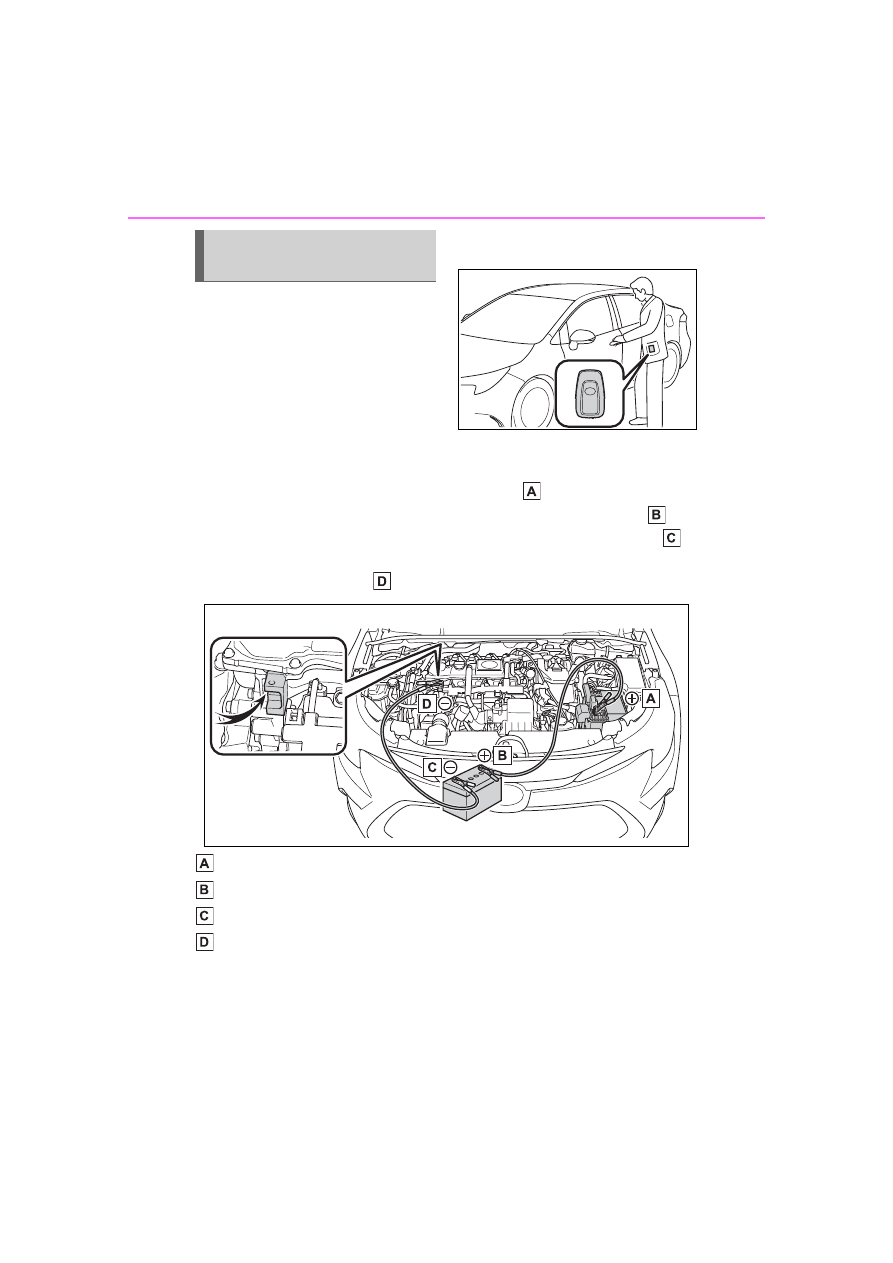
498
8-2. Steps to take in an emergency
If you have a set of jumper (or
booster) cables and a second
vehicle with a 12-volt battery,
you can jump start your vehicle
by following the steps below.
1
Confirm that the electronic
key is being carried.
When connecting the jumper (or
booster) cables, depending on the
situation, the alarm may activate
and doors locked. (
P.90)
2
Open the hood. (
3
Connect a positive jumper cable clamp to on your vehicle and
connect the clamp on the other end of the positive cable to on
the second vehicle. Then, connect a negative cable clamp to
on the second vehicle and connect the clamp at the other end of
the negative cable to .
Positive (+) battery terminal (your vehicle)
Positive (+) battery terminal (second vehicle)
Negative (-) battery terminal (second vehicle)
Solid, stationary, unpainted metallic point away from the battery
and any moving parts as shown in the illustration
4
Start the engine of the sec-
ond vehicle. Increase the
engine speed slightly and
maintain at that level for
approximately 5 minutes to
Restarting the hybrid sys-
tem
499
8-2. Steps to take in an emergency
8
Whe
n tr
ouble
ar
ises
recharge the 12-volt battery
of your vehicle.
5
Open and close any of the
doors of your vehicle with the
power switch OFF.
6
Maintain the engine speed of
the second vehicle and start
the hybrid system of your
vehicle by turning the power
switch to ON.
7
Make sure the “READY” indi-
cator comes on. If the indica-
tor does not come on, contact
your Toyota dealer.
8
Once the hybrid system has
started, remove the jumper
cables in the exact reverse
order from which they were
connected.
Once the hybrid system starts,
have the vehicle inspected at
your Toyota dealer as soon as
possible.
■
Starting the hybrid system
when the 12-volt battery is dis-
charged
The hybrid system cannot be started
by push-starting.
■
To prevent 12-volt battery dis-
charge
●
Turn off the headlights and the
audio system while the hybrid sys-
tem is off.
●
Turn off any unnecessary electri-
cal components when the vehicle
is running at a low speed for an
extended period, such as in heavy
traffic.
■
When the 12-volt battery is
removed or discharged
●
Information stored in the ECU is
cleared. When the 12-volt battery
is depleted, have the vehicle
inspected at your Toyota dealer.
●
Some systems may require initial-
ization. (
■
When removing the 12-volt bat-
tery terminals
When the 12-volt battery terminals
are removed, the information stored
in the ECU is cleared. Before
removing the 12-volt battery termi-
nals, contact your Toyota dealer.
■
Charging the 12-volt battery
The electricity stored in the 12-volt
battery will discharge gradually even
when the vehicle is not in use, due
to natural discharge and the drain-
ing effects of certain electrical appli-
ances. If the vehicle is left for a long
time, the 12-volt battery may dis-
charge, and the hybrid system may
be unable to start. (The 12-volt bat-
tery recharges automatically while
the hybrid system is operating.)
■
When recharging or replacing
the 12-volt battery
●
In some cases, it may not be pos-
sible to unlock the doors using the
smart key system when the
12-volt battery is discharged. Use
the wireless remote control or the
mechanical key to lock or unlock
the doors.
●
The hybrid system may not start
on the first attempt after the
12-volt battery has recharged but
will start normally after the second
attempt. This is not a malfunction.
●
The power switch mode is memo-
rized by the vehicle. When the
12-volt battery is reconnected, the
system will return to the mode it
was in before the 12-volt battery
was discharged. Before discon-
necting the 12-volt battery, turn
the power switch off.
If you are unsure what mode the
500
8-2. Steps to take in an emergency
power switch was in before the
12-volt battery discharged, be
especially careful when recon-
necting the 12-volt battery.
■
When replacing the 12-volt bat-
tery
●
Use a 12-volt battery that con-
forms to European regulations.
●
Use a 12-volt battery with the
same case size as the previous
12-volt battery and an equivalent
20 hour rate capacity (20HR) or
greater.
• If the sizes differ, the 12-volt bat-
tery cannot be properly secured.
• If the 20 hour rate capacity is low,
even if the time period where the
vehicle is not used is a short time,
the 12-volt battery may discharge
and the hybrid system may not be
able to start.
●
For details, consult your Toyota
dealer.
WARNING
■
When removing the 12-volt
battery terminals
Always remove the negative (-)
terminal first. If the positive (+) ter-
minal contacts any metal in the
surrounding area when the posi-
tive (+) terminal is removed, a
spark may occur, leading to a fire
in addition to electrical shocks
and death or serious injury.
■
Avoiding 12-volt battery fires
or explosions
Observe the following precautions
to prevent accidentally igniting the
flammable gas that may be emit-
ted from the 12-volt battery:
●
Make sure each jumper cable is
connected to the correct termi-
nal and that it is not unintention-
ally in contact with any other
than the intended terminal.
●
Do not allow the other end of
the jumper cable connected to
the “+” terminal to come into
contact with any other parts or
metal surfaces in the area, such
as brackets or unpainted metal.
●
Do not allow the + and - clamps
of the jumper cables to come
into contact with each other.
●
Do not smoke, use matches,
cigarette lighters or allow open
flame near the 12-volt battery.
■
12-volt battery precautions
The 12-volt battery contains poi-
sonous and corrosive acidic elec-
trolyte, while related parts contain
lead and lead compounds.
Observe the following precautions
when handling the 12-volt battery:
●
When working with the 12-volt
battery, always wear safety
glasses and take care not to
allow any battery fluids (acid) to
come into contact with skin,
clothing or the vehicle body.
●
Do not lean over the 12-volt bat-
tery.
●
In the event that battery fluid
comes into contact with the skin
or eyes, immediately wash the
affected area with water and
seek medical attention. Place a
wet sponge or cloth over the
affected area until medical
attention can be received.
●
Always wash your hands after
handling the 12-volt battery sup-
port, terminals, and other bat-
tery-related parts.
●
Do not allow children near the
12-volt battery.
501
8-2. Steps to take in an emergency
8
W
he
n
tro
ub
le
ar
is
es
If the engine coolant tempera-
ture gauge enters the red
zone or “Engine Coolant
Temp High Stop in a Safe
Place See Owner’s Manual”
is shown on the multi-informa-
tion display
1
Stop the vehicle in a safe
place and turn off the air con-
ditioning system, and then
stop the hybrid system.
2
If you see steam: Carefully lift
the hood after the steam sub-
NOTICE
■
When handling jumper cables
When connecting the jumper
cables, ensure that they do not
become entangled in the cooling
fans, etc.
If your vehicle over-
heats
The following may indicate
that your vehicle is over-
heating.
The engine coolant tem-
perature gauge (
P.96) is
in the red zone or a loss of
hybrid system power is
experienced. (For example,
the vehicle speed does not
increase.)
“Engine Coolant Temp High
Stop in a Safe Place See
Owner’s Manual” or “Hybrid
System Overheated Output
Power Reduced” is shown
on the multi-information dis-
play.
Steam comes out from
under the hood.
Correction procedures
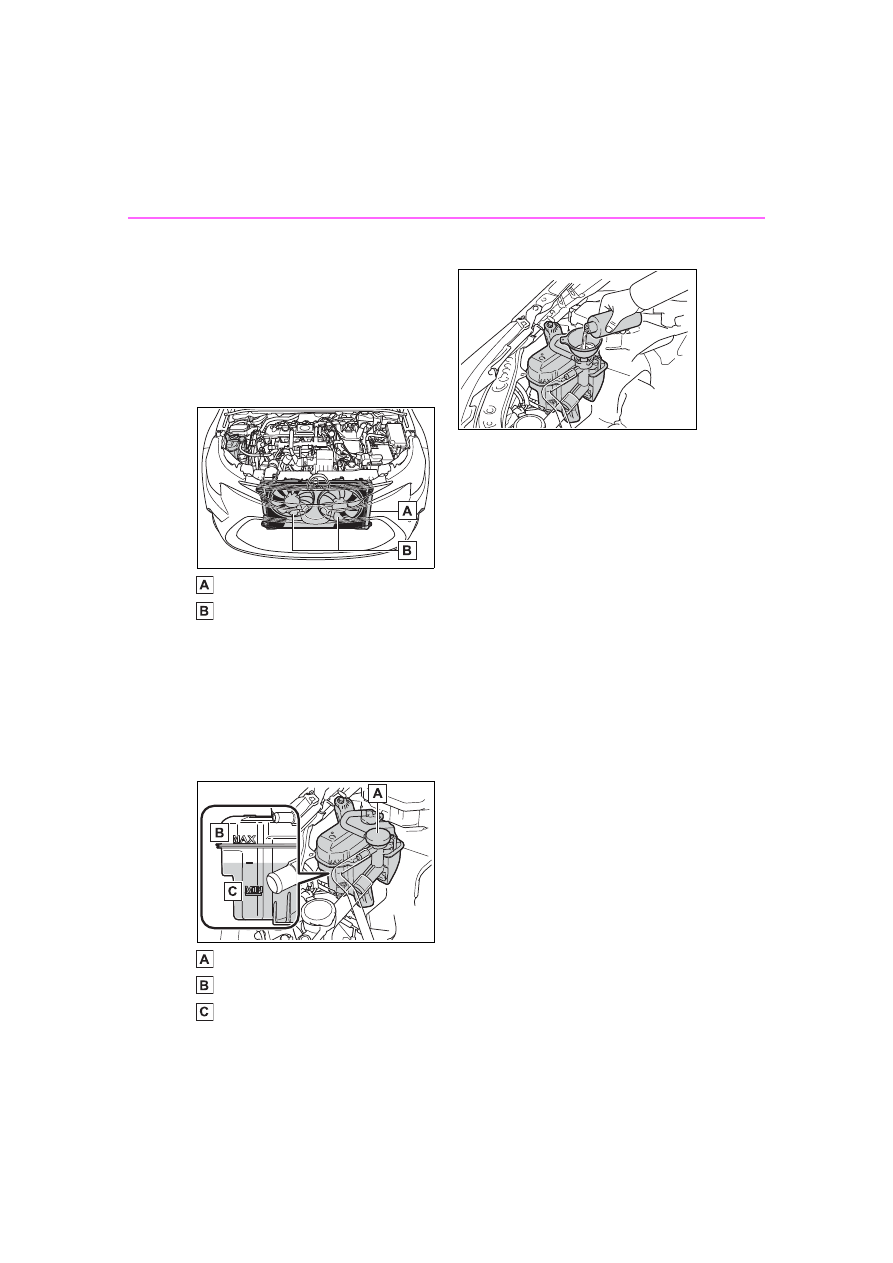
502
8-2. Steps to take in an emergency
sides.
If you do not see steam:
Carefully lift the hood.
3
After the hybrid system has
cooled down sufficiently,
inspect the hoses and radia-
tor core (radiator) for any
leaks.
Radiator
Cooling fans
If a large amount of coolant leaks,
immediately contact your Toyota
dealer.
4
The coolant level is satisfac-
tory if it is between the “MAX”
and “MIN” lines on the reser-
voir.
Reservoir
“MAX” line
“MIN” line
5
Add coolant if necessary.
Water can be used in an emer-
gency if coolant is unavailable.
6
Start the hybrid system and
turn the air conditioning sys-
tem on to check that the radi-
ator cooling fans operate and
to check for coolant leaks
from the radiator or hoses.
The fans operate when the air con-
ditioning system is turned on imme-
diately after a cold start. Confirm
that the fans are operating by
checking the fan sound and air flow.
If it is difficult to check these, turn
the air conditioning system on and
off repeatedly. (The fans may not
operate in freezing temperatures.)
7
If the fans are not operating:
Stop the hybrid system
immediately and contact your
Toyota dealer.
If the fans are operating:
Have the vehicle inspected at
the nearest Toyota dealer.
If “Hybrid System Over-
heated Output Power
Reduced” is shown on the
multi-information display
1
Stop the vehicle in a safe
place.
2
Stop the hybrid system and
carefully lift the hood.

503
8-2. Steps to take in an emergency
8
W
he
n
tro
ub
le
ar
is
es
3
After the hybrid system has
cooled down, inspect the
hoses and radiator core (radi-
ator) for any leaks.
Radiator
Cooling fans
If a large amount of coolant leaks,
immediately contact your Toyota
dealer.
4
The coolant level is satisfac-
tory if it is between the
“FULL” and “LOW” lines on
the reservoir.
Reservoir
“FULL” line
“LOW” line
5
Add coolant if necessary.
Water can be used in an emer-
gency if coolant is unavailable.
6
After stopping the hybrid sys-
tem and waiting for 5 minutes
or more, start the hybrid sys-
tem again and check for the
multi-information display.
If the message does not dis-
appear: Stop the hybrid sys-
tem and contact your Toyota
dealer.
If the message is not dis-
played: The hybrid system
temperature has dropped
and the vehicle may be
driven normally.
However, if the message appears
again frequently, contact your Toy-
ota dealer.
WARNING
■
When inspecting under the
hood of your vehicle
Observe the following precau-
tions. Failure to do so may result
in serious injury such as burns.
●
If steam is seen coming from
under the hood, do not open the
hood until the steam has sub-
sided. The engine compart-
ment may be very hot.

504
8-2. Steps to take in an emergency
1
Stop the hybrid system. Set
the parking brake and shift
the shift lever to P.
2
Remove the mud, snow or
sand from around the front
wheels.
3
Place wood, stones or some
other material under the front
wheels to help provide trac-
tion.
4
Restart the hybrid system.
5
Shift the shift lever to D or R
and release the parking
brake. Then, while exercising
caution, depress the acceler-
ator pedal.
■
When it is difficult to free the
vehicle
Press the
switch to turn off
TRAC.
WARNING
●
After the hybrid system has
been turned off, check that the
“READY” indicator is off. When
the hybrid system is operating,
the gasoline engine may auto-
matically start, or the cooling
fans may suddenly operate
even if the gasoline engine
stops. Do not touch or approach
rotating parts such as the fan,
which may lead to fingers or
clothing (especially a tie, a scarf
or a muffler) getting caught,
resulting in serious injury.
●
Do not loosen the coolant reser-
voir caps while the hybrid sys-
tem and radiator are hot.
High temperature steam or
coolant could spray out.
NOTICE
■
When adding engine/power
control unit coolant
Add coolant slowly after the
hybrid system has cooled down
sufficiently. Adding cool coolant to
a hot hybrid system too quickly
can cause damage to the hybrid
system.
■
To prevent damage to the
cooling system
Observe the following precau-
tions:
●
Avoid contaminating the coolant
with foreign matter (such as
sand or dust etc.).
●
Do not use any coolant additive.
If the vehicle becomes
stuck
Carry out the following pro-
cedures if the tires spin or
the vehicle becomes stuck
in mud, dirt or snow:
Recovering procedure

Нет комментариевНе стесняйтесь поделиться с нами вашим ценным мнением.
Текст